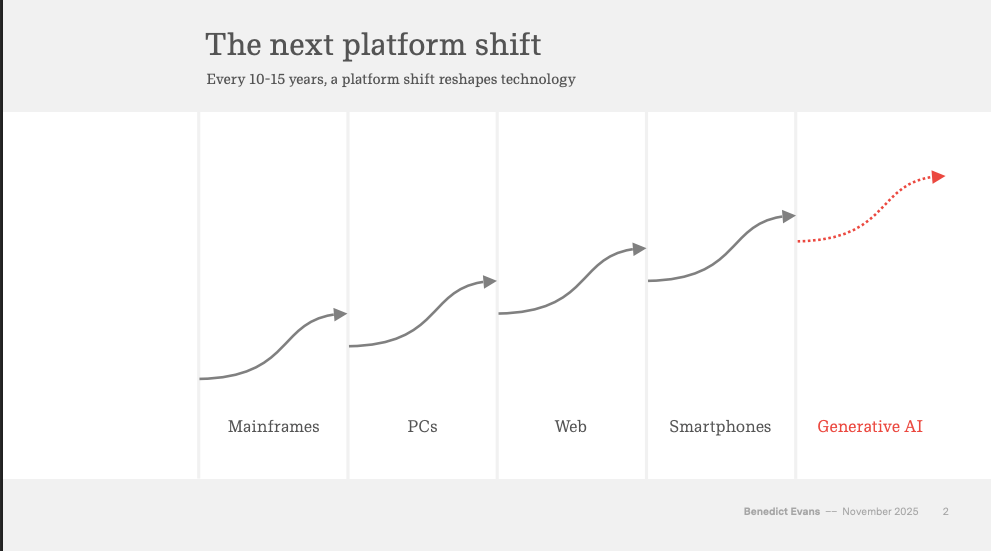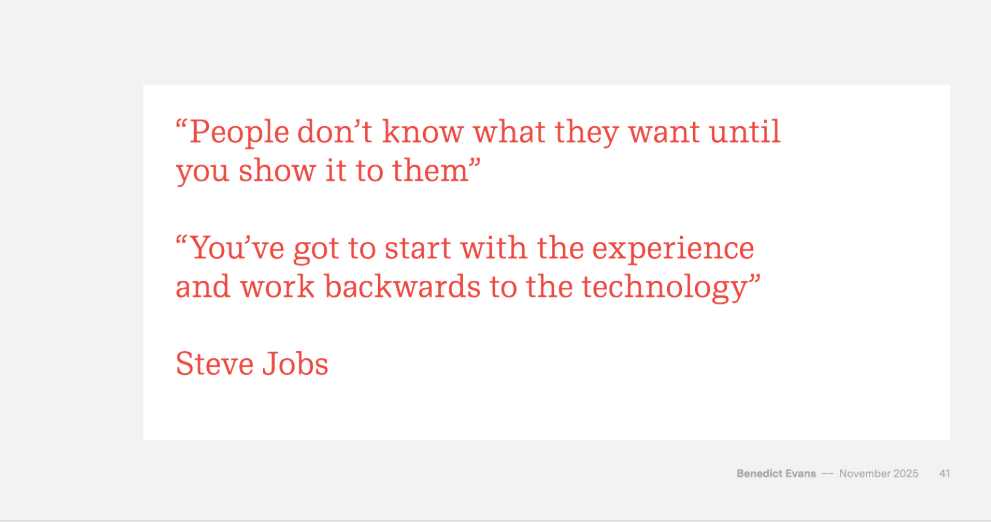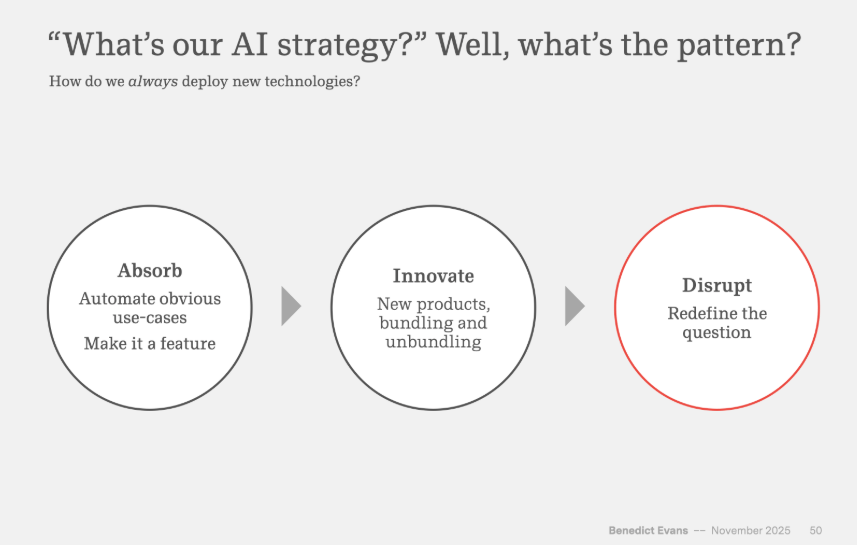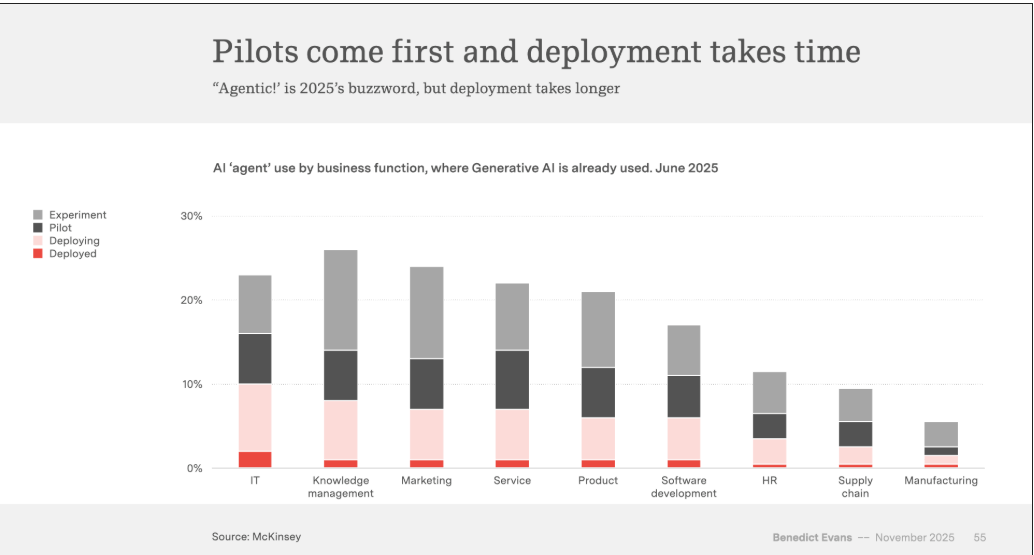8 bits for a Byte: As we look ahead into the future of AI, a profound shift is underway—one that calls for far more than just keeping pace with technological advances. It's about anticipation, understanding not only where AI is but where it's headed. Emerging trends suggest that AI is moving beyond automating tasks to fundamentally reshaping industries by becoming an integral part of strategic decision-making. This means that the organizations readying themselves today are those that grasp the full narrative of AI progression, from its evolutionary roots to the potential future it is ushering in.
Reflecting on AI’s trajectory reveals a cyclical pattern of incremental growth often followed by transformative breakthroughs, each wave bringing new possibilities and fresh challenges. The next phase of AI, with technologies like generative AI and real-time analytics, promises to accelerate this pace of change. But it demands strategic foresight, understanding, and preparation—a chance to pivot quickly and adeptly in response to unforeseen opportunities and disruptions.
This newsletter is positioned as strategic intelligence for forward-thinking professionals who wish to harness AI not as a series of isolated tools, but as a foundational pillar in navigating today’s—and tomorrow’s—business landscapes. My role, as an AI Strategist, is to demystify these trends, offering a vantage point from which you can not only see around the corners of technology's advancement but also strategize effectively in your adoption and risk management approaches. Leading with a structured, adaptive mindset, and recognizing AI’s role in a broader economic and societal evolution, positions you not only for survival but for sustainable success in an AI-defined future.


Let’s Get To It!

Welcome To AI Quick Bytes!
Bit 1:
Ever notice how AI progress always seems to sneak up on us? One minute, things are humming along—and then, out of nowhere, there’s a leap forward that leaves businesses scrambling. I’ve seen more than a few organizations caught flat-footed by these shifts, learning the hard way that betting on the status quo is a risky move.
A close look at AI’s history reveals a repeating cycle: periods of incremental improvement punctuated by sudden breakthroughs. Each of these inflection points—think rules-based systems to machine learning, then on to generative AI—has blindsided companies clinging to yesterday’s best practices. The fallout? Costly technology overhauls, talent shortages, and lost market share. The real takeaway is that understanding these historical cycles isn’t about chasing hype; it’s a core risk management strategy. By staying attuned to past disruptions, leaders can design more adaptable tech roadmaps, forecast skill shifts, and sidestep the trap of technological complacency.
The message is clear: AI’s evolution is as much a cautionary tale as it is an opportunity. Organizations need to prepare for volatility, not just steady progress—and make sure they can pivot quickly when the next breakthrough hits.
Complacency comes at a price: Ignoring historical AI cycles all but guarantees disruption. Build proactive scenario planning into your resilience strategy.
Obsolescence moves faster now: Each new leap in AI shortens the shelf life of your tools and processes. Frequent, honest audits are your safeguard.
Talent needs are always shifting: Tomorrow’s AI demands new skills—continuous upskilling isn’t optional, it’s survival.
ACTION BYTE: At your next tech risk review, include a “history check”—benchmark your vulnerability to sudden AI shifts by studying past industry disruptions and how others responded.

Find customers on Roku this holiday season
Now through the end of the year is prime streaming time on Roku, with viewers spending 3.5 hours each day streaming content and shopping online. Roku Ads Manager simplifies campaign setup, lets you segment audiences, and provides real-time reporting. And, you can test creative variants and run shoppable ads to drive purchases directly on-screen.
Bonus: we’re gifting you $5K in ad credits when you spend your first $5K on Roku Ads Manager. Just sign up and use code GET5K. Terms apply.

Bit 2:
Quote of the Week:
"In the fast-paced world of AI, the real challenge is not just keeping up with innovation, but translating it into meaningful change."

Bit 3:
It’s easy to get swept up in the potential of real-time AI analytics. But if history has taught us anything, it’s that every technological leap comes with its own set of risks. The shift to instant insights is no different. The real question isn’t just whether you can implement these tools—but whether you’re ready for the operational, ethical, and cultural challenges that come with them.
Real-time data analysis means making critical decisions on the fly, often without the luxury of complete information. If your organization isn’t prepared to trust, interpret, and act on AI-driven recommendations, you risk being buried in noise—or worse, making costly mistakes at scale. The accelerated pace of decision-making can also expose weaknesses in governance and data quality—issues that, if ignored, can quietly erode trust and draw the attention of regulators.
To capture the upside while managing the downside, leaders must balance excitement with discipline. That starts with investing in robust data governance, establishing clear escalation protocols, and providing ongoing training for your teams. As with any powerful new tool, success belongs to those who prepare thoughtfully—not just those who move quickly.
Data quality and governance are now mission-critical. Real-time insights are only as reliable as the data driving them; poor data can lead to poor decisions at unprecedented speed.
Decision fatigue and automation overreliance are genuine risks. Leaders need clear guidelines for when to trust the machine—and when to pause for human judgment.
Ethical and compliance challenges grow as speed increases. Without strong oversight, mistakes or biases in real-time systems can quickly ripple across the organization and beyond.
ACTION BYTE: Before rolling out real-time AI analytics, conduct a risk assessment focused on your data quality, governance, and decision-making processes. Create a playbook that clarifies when to trust—and when to challenge—AI-generated insights.

Bit 4:
AI often feels like a magic show—spectacular up front, but complicated behind the curtain. As enterprise leaders, it’s tempting to get swept up in the hype and overlook the gritty realities underneath. Yet, the path to real AI adoption is routinely blocked by these three stubborn technical hurdles: data quality, model transparency, and raw computational power. Even more important is the hurdle of winning over and training your workforce to make the transition to an AI driven workflow.
Why does this matter so much right now? The headlines might declare an AI revolution, but for most organizations, the real choke points aren’t moonshot ambitions—they’re the nuts and bolts. If your data is unreliable, your models are opaque, or your infrastructure can’t handle the load, you simply won’t deliver the results your leadership expects. These technical gaps don’t just slow progress; they can derail entire projects, wasting investments and, all too often, denting organizational credibility. If your employees are fearful of AI then they will find ways to make sure it does not work.
If history has taught us anything—from the early internet boom to the rise of cloud computing—it’s that winners master the basics before chasing the next big thing. AI is no exception. Every breakthrough is only as strong as its weakest technical / human link, and ignoring these foundational issues can turn promising initiatives into cautionary tales.
Data: The Oil That Must Be Refined: Flawed or incomplete data can sink even the best AI projects. Make data governance and cleansing a top priority to prevent small errors from multiplying at scale.
Trust Demands Transparency: The “black box” problem isn’t just academic—it’s one of the biggest barriers to adoption, especially in regulated or high-risk sectors. Prioritize interpretable models that offer clear audit trails and actionable insights.
Know Your Limits: Scaling AI requires serious computational muscle. Take a hard look at your infrastructure, consider cloud partnerships, and set realistic goals that match your technical capacity.
Train and Upskill: Your workforce, they are the the life blood that will drive your ultimate success.
ACTION BYTE: Before greenlighting your next AI initiative, gather a cross-functional team to review your data pipeline, model explainability needs, and compute / people resources. This proactive technical audit will help you avoid costly setbacks and keep your AI journey on course.

Bit 5:
Ever feel like AI is simultaneously leveling the playing field and splitting it wide open? I see it every day: the companies pulling ahead aren’t just automating—they’re fundamentally reinventing how they create value. The real differentiator isn’t the tech itself, but how you translate innovation into measurable ROI.
We’ve seen this play out before—think back to music’s leap from vinyl to streaming, where the value shifted from units sold to user engagement. AI is now driving a similar transformation across every industry, favoring those who move early and measure obsessively. Subscriptions powered by AI, on-demand analytics, and smart product offerings are quickly becoming the norm. But the organizations that truly win are the ones that turn these advances into ongoing, quantifiable impact. In this new landscape, advanced ROI frameworks aren’t just nice to have—they’re your north star, turning innovation into sustainable competitive advantage rather than just more noise.
As the AI race accelerates, the divide will only grow between companies that wield ROI as a strategic tool and those that simply follow the latest trends. The future belongs to leaders who treat data-driven ROI as both shield and sword—guarding their investments while unlocking the next wave of growth.
ROI as a competitive weapon. Early movers who define and track new value drivers will set the standards others are forced to match.
Continuous learning loops. AI-powered models allow rapid iteration, but only those with rigorous ROI measurement will reap compounding benefits. The early 2000s motto fail fast is an anachronism, today in Silicon Valley it is all about learning fast.
Strategic pivots, not sunk costs. Clear metrics empower teams to double down or pivot fast, minimizing wasted resources and capturing first-mover advantages.
ACTION BYTE: Assemble a dedicated, cross-functional “ROI Tiger Team” to continuously track, analyze, and optimize the results of your AI-driven business models. Make ROI measurement an ongoing, strategic discipline—not just an annual checkbox.

Bit 6: Sunday Funnies

Voice AI: Get the Proof. Avoid the Hype.
Deepgram interviewed 400 senior leaders on voice AI adoption: 97% already use it, 84% will increase budgets, yet only 21% are very satisfied with legacy agents. See where enterprises deploy human-like voice AI agents - customer service, task automation, order capture. Benchmark your roadmap against $100M peers for 2026 priorities.

Bit 7:
Ever feel like rolling out AI in the enterprise is less like launching a product and more like tiptoeing through a minefield? Between entrenched cultures, outdated systems, and teams that aren’t quite in sync, it’s easy to see why so many promising pilots stall out. The real pitfall isn’t just a technical glitch—it’s organizational drift, where momentum fizzles and opportunities fade. If history has taught us anything, it’s that ignoring the human side of change is a recipe for missed potential.
Here’s the good news: risk management isn’t just about defense—it’s about building resilience from the start. According to the AI 2025 Roadmap, enterprises that put cross-functional governance front and center are far better positioned to spot and address risks early. Bringing together leaders from data, IT, business, and operations creates a shared space to surface friction points before they escalate. This isn’t just about avoiding failure; it’s about building the organizational reflexes you’ll need for every AI project down the line.
Early risk detection: Diverse, cross-functional teams can flag integration and adoption hurdles before they threaten deployment.
Governance as insurance: Clear accountability and streamlined escalation channels dramatically lower the odds of project failure.
Sustained readiness: Embedding collaboration into your culture sets you up to tackle future waves of AI complexity with confidence.
ACTION BYTE: Before greenlighting your next AI pilot, set up a cross-functional governance council with a clear mandate to identify and manage organizational risks throughout the entire project lifecycle.

Bit 8:
Ever notice how AI transformation isn’t just about the tech—it’s about the teams using it? The smartest algorithms in the world won’t move the needle if your people can’t keep up. In today’s fast-moving marketplace, the real competitive edge comes down to how quickly your workforce can adapt and grow alongside your technology.
Here’s the reality: upskilling is no longer a “someday” initiative. It’s a critical lever for immediate business impact. Companies making targeted investments in training—not just for engineers, but across every function—see faster adoption, fewer operational hiccups, and a surge in creative problem-solving. Recent AI roadmaps confirm this: well-designed upskilling programs accelerate the journey from experimentation to real-world results, drastically reducing the time it takes to scale successful pilots.
When employees understand the tools at their fingertips and feel empowered to experiment, you unlock initiative at every level. This shift leads to sharper workflows, less friction between teams, and a more resilient competitive position. Think back to the early internet era—the organizations that helped their people master the digital landscape quickly outpaced those that treated new tech as an isolated IT project.
Faster time-to-value: Teams fluent in AI can spot opportunities, adapt processes, and deliver results before competitors even get started.
Reduced implementation friction: Upskilled employees bridge the divide between technical and business groups, cutting down on miscommunication and stalled initiatives.
Higher employee engagement: Ongoing learning sparks curiosity and ownership—fueling both retention and innovation.
ACTION BYTE: Kick off a 90-day upskilling sprint in a core business function. Blend technical training with hands-on problem-solving projects, and track gains in both adoption speed and process efficiency.

Until next time, take it one bit at a time!
Rob
P.S. Thanks for making it to the end—because this is where the future reveals itself.
Translating AI insight into structured, staged business action for future-proofing organizations
If you feel overwhelmed by the pace of AI change, you’re not alone. But here’s the reality: the AI revolution isn’t slowing down for anyone—and neither should your organization. The winners in this new era will be those who turn AI insights into practical, staged actions. Think of AI readiness less as a mad dash and more as a relay race—each well-executed handoff gets your team closer to the finish line.
Many companies are sitting on a wealth of AI knowledge (Your Proprietary Data), yet only those who actually put it into practice will see real results. Future-proofing your business in the AI age means breaking the journey into clear, manageable stages: start by understanding where you are, experiment where you can win, and stay alert to shifts in technology and policy. This staged approach helps you manage risk, transforming what feels overwhelming into something actionable.
Why is this incremental approach so critical? Because in today’s business landscape, steady progress beats standing still. AI moves too fast for perfectionism—the organizations that treat AI readiness as an ongoing, adaptive process are the ones best positioned to capture new opportunities and sidestep threats. The data is clear: early, iterative movers consistently outperform those who hold out for the “perfect” plan.
Benchmark before you build: Conduct an AI readiness assessment to identify not just technical shortfalls, but also cultural and process gaps. This clarity leads to smarter, more targeted investments.
Pilot, don’t plunge: Run small, high-impact experiments to learn quickly, fail safely, and build internal advocates for broader adoption.
Institutionalize trend tracking: Set up regular monitoring to keep your strategy aligned with evolving technology and regulations, ensuring your organization stays agile.
ACTION BYTE: Bring together a cross-functional AI task force this quarter to run a rapid readiness assessment, kick off a focused pilot, and set a quarterly cadence for tracking AI trends. The future isn’t waiting—your organization shouldn’t either.








